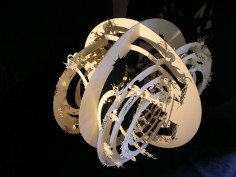INGRID SILIAKUS
Ингрид Силиакус

source: ingrid-siliakusexto
Ingrid Siliakus first discovered paper architecture by seeing work of the originator of this art form Prof. Masahiro Chatani (architect and professor in Japan). He developed this art form in the early 1980’s. Ingrid was instantly fascinated by the ingenious manner in which these pieces were designed and by the beauty they radiated. Ingrid studied the originator’s work for some years and than started to design herself. Ingrid states that working with this art form has given her personal means of expressing. Her designing skills have grown over the years. Her specialties are buildings of master architects and intricate abstract sculptures. Her source of inspiration by these abstract sculptures are works of artists like M.C. Escher. With buildings she feels attracted to work of Berlage and Gaudi.
Paper Architecture is the art of creating an object out of a single piece of paper. Before the final design is finished, something like 20 to 30 (sometimes even more) prototypes are made by Ingrid. Drawing paper architecture designs to Ingrid is as building: first one layer, with a single shape, will be drawn and than layer after layer are added. This process continues till she is satisfied with the result. All separate prototypes are cut and folded, to be examined by her. To design a pattern from scratch, the artist needs the skills of an architect to create a two-dimensional design, which, with the patience and precision of a surgeon, becomes an ingenious three-dimensional wonder of paper. After the design stage, creating a paper architecture art work is done by a combination of detailed cutting and folding. The paperweight Ingrid uses for her creations varies from 160 to 300 gram.
Statement of the artist (for the Holland Paper Exhibition in 2006): ‘…Working with paper forces me to be humble, since this medium has a character of its own that asks for cooperation. It is a challenge to find this cooperation with each separate paper brand I work with. Working with paper the way I do, namely by means of cutting and folding creating paper sculptures, asks of me to work with meditative precision. Paper architecture does not bare haste, it is its enemy; one moment of loss of concentration, can lead to failure of a piece…’ ‘…I experience an ultimate satisfaction at the critic moment when the paper, with a silenced sigh, surrenders and becomes a blade-sharp crease. The sound of the paper, which guides this surrendering, to me is incomparable…’
.
.
.
.
.
.
.
source: liveinternetru
Бумажная архитектура – это искусство создания бумажных моделей из одного листа бумаги, который надрезается и складывается самым разнообразным способом. Чаще всего разрабатываются трехмерные инсталляции архитектурных объектов, геометрических узоров и различных повседневных объектов.
Ингрид Силиакус (Ingrid Siliakus) впервые открыла для себя бумажную архитектуру, увидев работы создателя этого вида творчества японского профессора Масахиро Чатани (Masahiro Chatani, котрый занимается изучением и развитием данного направления с начала 1980-х годов. Ингрид была просто очарована искренней и подробной манерой дизайна бумажных шедевров и той
В течение нескольких лет Ингрид Силиакус изучала мастерство бумажной архитектуры, которая дает ей собственные средства самовыражения. Приобретенные за 15 лет творческой деятельности дизайнерские навыки и умения позволяют художнице создавать архитектурные шедевры и удивительные абстрактные скульптуры.
.
.
.
.
.
.
.
source: museumrijswijknl
Siliakus’ passie voor papier ontstond na het ontdekken van papierarchitectuur. Hierbij wordt uit één vel papier een driedimensionaal object gevormd door het papier te snijden en te vouwen. De ingenieuze en complexe constructies berekent Siliakus tot op de honderste millimeter en aan het eindproduct gaan vele proefmodellen en talloze aanpassingen vooraf. Pas als het ontwerp helemaal naar haar zin is, kan ze gaan snijden en vouwen. Ook dit geschiedt met de uiterste nauwkeurigheid.
.
.
.
.
.
.
.
source: k2idea
阿姆斯特丹的艺术家 ingrid siliakus,抽象的利用纸张做为最好的媒介进行纸上雕塑,一层层复杂但足够清晰的空间关系,被精悍而艺术的技术及超现实的想象力而表现的比现实建筑更加宏伟美好。
.
.
.
.
.
.
.
source: espaperblog
Esta artista holandesa descubrió por primera vez la arquitectura de papel cuando conoció el trabajo del profesor Masahiro Chatani (arquitecto japonés) que la desarrolló a comienzo de los 80.
Ingrid estudió su trabajo durante algunos años y luego comenzó a diseñar sus primeros proyectos.
Actualmente está considerada una de las artistas más influyentes y ha expuesto sus obras en los museos más importantes de arte contemporáneo.
Ella se declara una enamorada de la técnica del origami y la papiroflexia, le fascina su sonido mientras lo trabaja y las posibilidades infinitas que ofrece una simple lámina de papel.
Se ha especializado en reproducir obras de maestros de la arquitectura como MC Escher, Berlage o Gaudí, y también tiene una extensa colección de esculturas abstractas.
.
.
.
.
.
.
.
source: jejswiatpl
Co można zrobić z kartki papieru, oprócz wizytówek osobistych? Co zrobić, by nie marnować papieru w biurze? A może chcesz zaoszczędzić na prezentach? Sztuka składania papieru bywa ograniczona jedynie wyobraźnią.
Holenderska artystka Ingrid Siliakus stworzyła papierową architekturę. Tego typu dziedzina sztuki została wymyślona już w latach 80. XX wieku przez profesora Masahiro Chataniego. Najdziwniejsze budynki świata mogą powstać z papieru. Ingrid Siliakus stworzyła nie tylko minimalistyczne obiekty architektoniczne, ale też papierowe abstrakcje.

